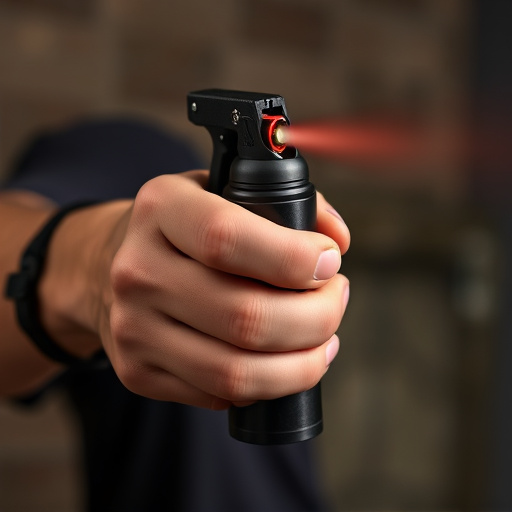The strongest legal pepper spray concentration for self-defense ranges from 2% to 5% capsaicin, offering effective deterrence without causing permanent harm. This concentration is widely permitted by most regions for civilian use, while concentrations above 5% are typically reserved for law enforcement. When choosing a pepper spray, look for products with longer reach and prolonged effects duration. Always check local laws regarding ownership and usage, store it securely yet accessible, and use it responsibly at safe distances from assailants and bystanders.
Staying safe in today’s world requires proactive measures, and self-defense is a crucial aspect. Pepper spray, an effective non-lethal weapon, offers a powerful deterrent against potential threats. This comprehensive guide explores the safety and effectiveness of pepper spray as a personal defense tool. From understanding its active ingredients to navigating legal restrictions on concentration levels, we’ll help you choose the strongest legal pepper spray for your needs while ensuring safe handling and responsible ownership.
- Understanding Pepper Spray: What It Is and How It Works
- Legal Considerations: Which Pepper Spray Concentration is Safe and Legal?
- Choosing the Right Pepper Spray for Self-Defense
- Safety Tips for Carrying and Using Pepper Spray Effectively
Understanding Pepper Spray: What It Is and How It Works
Pepper spray, a self-defense weapon designed to temporarily incapacitate an aggressor, is a compound that disrupts an individual’s vision and breathing by targeting the eyes, nose, and respiratory system. It works by causing intense irritation, leading to tears, coughing, and difficulty breathing, allowing the user time to escape or de-escalate the situation. The effectiveness of pepper spray lies in its concentration, measured in capsaicin units (OCs). The strongest legal pepper spray concentration typically ranges from 2 million to 5 million OCs, ensuring a powerful enough punch to deter attackers while adhering to legal limits.
Understanding the mechanism behind pepper spray is crucial for responsible usage. Unlike traditional firearms or stun guns, pepper spray doesn’t cause permanent harm but rather provides a temporary window of safety. Knowing the recommended application techniques and understanding that distance and angle are key factors in its effectiveness, empowers individuals to make informed decisions about self-defense, choosing a product with the right concentration for their needs.
Legal Considerations: Which Pepper Spray Concentration is Safe and Legal?
When considering pepper spray as a self-defense weapon, one of the most crucial aspects to understand is the legal concentration allowed. The strength and legality of pepper spray are measured in capsaicin units (or percent), which denote the amount of capsaicinoids—the chemical compound responsible for the burning sensation—present in the spray. While many manufacturers market “strongest” or “most potent” sprays, it’s essential to grasp that legal limitations vary by jurisdiction.
In most regions, law enforcement-grade pepper spray is authorized, typically containing a concentration between 2% and 5%. This range ensures effectiveness without crossing into excessive levels that could cause permanent harm. Using pepper spray above 5% capsaicin concentration is often prohibited for civilian use due to potential long-term health risks and the risk of misusing it, leading to accidental injuries. Always check local laws and regulations regarding pepper spray ownership, carry, and usage to ensure compliance and personal safety.
Choosing the Right Pepper Spray for Self-Defense
When selecting a pepper spray for self-defense, understanding the active ingredient concentration is paramount. The strongest legal pepper spray concentration typically ranges from 2% to 5%. Opting for a higher concentration ensures maximum efficacy against potential attackers. This is crucial as it determines the spray’s ability to cause temporary blindness and respiratory distress in an assailant.
Additionally, consider factors like range and duration of effect. A longer reach allows for safer distance from an attacker, while a prolonged effects time gives you more time to escape. Always ensure the pepper spray is legal in your area, readily available, and comes with clear instructions for safe and effective use.
Safety Tips for Carrying and Using Pepper Spray Effectively
When carrying pepper spray for self-defense, it’s crucial to prioritize safety and responsibility. Always store your spray in a secure, easily accessible location, out of reach of children and unauthorized individuals. Keep it charged and regularly inspect the expiration date, ensuring you’re prepared with the strongest legal pepper spray concentration available.
During use, maintain a safe distance from the assailant, aiming for their eyes and face. Apply the spray in quick bursts, moving back immediately after each application to avoid cross-contamination. Be aware of surrounding environments; do not use pepper spray where it could affect bystanders or enter bodies of water. Familiarize yourself with local laws regarding self-defense weapons, specifically focusing on legal pepper spray concentration limits and permitted uses.
When it comes to self-defense, choosing the right pepper spray is essential. Understanding the legal implications of various concentrations, such as the strongest legal pepper spray concentration available, and adhering to safety guidelines are paramount. By selecting a reliable brand and keeping your spray readily accessible, you can arm yourself with a powerful tool while prioritizing safety. Remember, proper training and responsible handling are key to effectively deploying pepper spray when needed.
